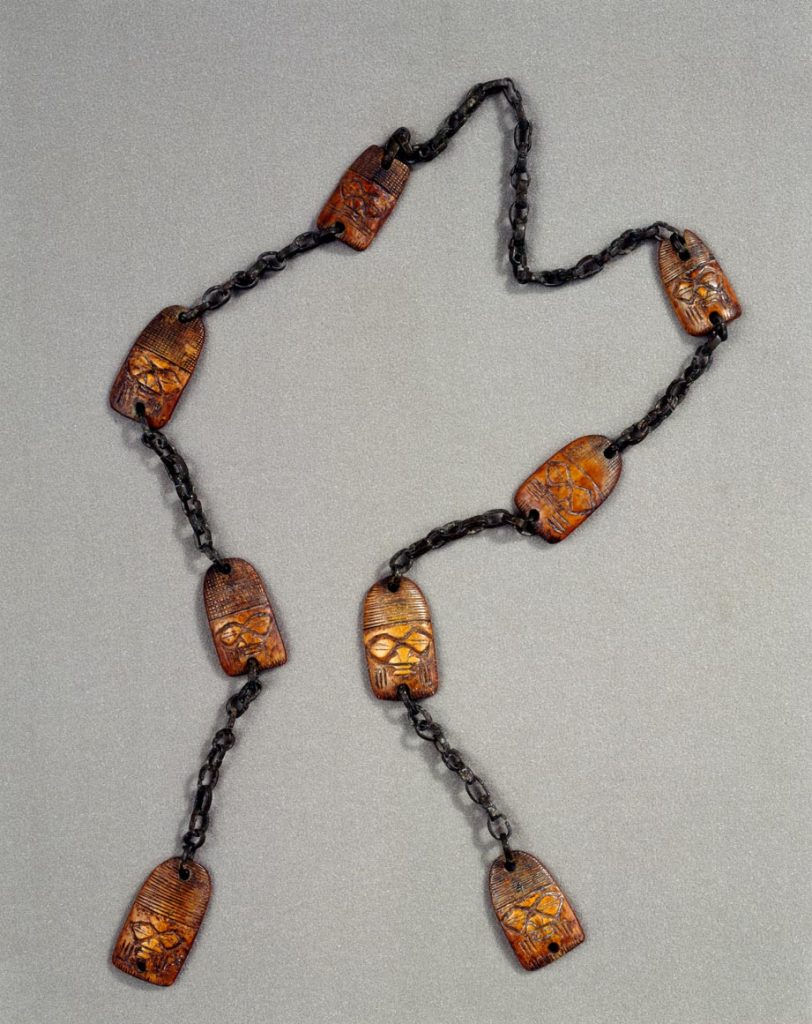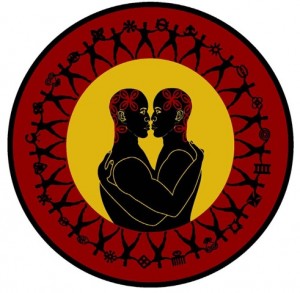Cosmological Queerness Across the Yoruba Diaspora

The constellating topics of homosexuality and masculinity are perennial to Black American discourses. In contemporary debates, the chorus shouting loudest in defense of traditional sexual and gender expressions arises in part from a curious convergence between the Protestant Black Church and Afrocentrist conscious movements, the so-called Hoteps*.1 Despite the Hotep* contention that Black Christianity is a colonial imposition left over from white slave masters, both groups broadly share an aversion to homosexuality and gender nonconformance. They generally espouse essentialist understandings that Black men (those with male bodies) should “act like men” and Black women (those with female bodies) should “act like women.”
These two divergent Black subcultures share profound similarities from the perspective of mythology. Mythology deals with origin stories—stories we repeat to ourselves that orient us in time and space and present us with a view of how the world works and our place within it. Nowhere does mythology’s importance come into sharper view than when contemplating the Middle Passage. Africans, forcibly removed from their communities, arrived in the Americas with the burden of having to keep on living. However, the semiotic domination of the master’s language, metaphysics, religion, and categories of meaning now mediated this American life. Nevertheless, African knowledge persisted as Africans resisted.
Though a great deal of Black Christian theology today shares much in common with its white Christian counterpart, Diasporic Christianities still bear the imprint of distinctly African sensibilities. One example is the ritual expectation of how Spirit manifests through bodies in worship settings. Hoteps* too have elaborated mythologies that seek to undo the disruptions of the Middle Passage by appropriating a symbolic image of Africa before the Transatlantic Slave Trade (centered in Kemet/Egypt), free of the white man’s chains and his Jesus. To the extent that these mythologies create a life of rootedness out of the fragments of the Middle Passage, the projects of Black Christianity and Hotep* Afrocentrism are the same.
However necessary these Diasporic projects, they do not embrace expansive intimacy. Each has operationalized homophobic discourses. Pauline Christian theology opposes hedonism in all forms, a prohibition that discounts homosexual acts since their pleasures cannot lead to biological procreation. Hoteps* originate Black male homosexuality to slavery and the imaginary practice of “buck breaking,” in which slave owners publicly penetrated their male slaves. Black Lesbianism then emerged in the gap created by the master’s emasculation of the Black man. Each subculture devalues the homosexual act by denying it any erotic or intimate significance. Black queer voices utter a contrary word and give testimony to the destructive effects the continued taboos on homosexuality and gender nonconformance wreak in their lives. It is this pain—the homelessness of Black queer youth, the mounting numbers of murdered transgender Black women and femmes—that implore us to find another way. We must create a new mythology, or rediscover in old ones new principles for living that hasten liberation.
It is in this spirit that I hold up the Yoruba cosmology, briefly detailing its sexual and gender complexities and their ethical considerations. As a well-documented cultural system with wide dispersion and influence across the Diaspora—including Brazil, Cuba, the Caribbean, and the United States—Yoruba cosmology presents alternative schemas for imagining and enacting Black life in the African Americas. The Yoruba worldview is one of ontological wholeness, this fullness culminating in the supreme being Olodumare. Genderless, or possessing all possible gender expressions simultaneously, Olodumare’s plenitude is permeated by ashe, the divine energy and power that brings things into existence, the potential from which emerges the infinity of forms that populate Olodumare’s realms. Ashe sustains these forms in substantial unity through their infinite permutations and iterations. Because Olodumare exceeds the scope of human comprehension, aspects of Olodumare’s ashe condense within orishas.
Though sometimes likened to gods, orishas are properly understood as avatars, or personifications of ashe that relate to natural forces. It is important to understand that orishas are not the “reservoir” of ashe, nor its source or generator. Undifferentiated ashe is always already present throughout the cosmos and seeks expression within forms of matter and natural phenomena that then double as personifications within an orisha. As social beings, the orishas form a special way to relate the workings of ashe to the human condition. The legends of orishas form pataki, or proverbs that record their dealings and provide orature for interpretation related to human affairs by consulting Ifá, the orisha of divination. When a questioner comes for a consultation, the babalawo (priest) will use a divination chain made from eight pieces of coconut husk (epuele) to obtain 16 possible results called odu that correspond to the legends of the orishas. This base-16 expands to 256 odu containing 4,096 ese, or individual verses recorded within the Yoruba corpus. The priest interprets the rich metaphors and figurative prose of the odu to read the questioner. When gender and sexuality figure within the odu, we see a complexity in excess of the base-2 system of gay/straight and male/female so entrenched within Western socialities.

Let’s start with Eshu-Elegbara, the orisha of the crossroads. Called Eleggua in Cuba, Papa Legba in Haiti, Exú in Brazil, and related to the signifyin(g) monkey tales in the United States, this trickster is the keeper of the gate between cosmic and human consciousness. He is the process of human sense-perception and cognition, as well as the logic that undergirds and makes understanding possible. Eshu interprets one’s destiny from Ifá to the babalawo during divination. In one legend, this trickster’s sexual appetite cursed him with a perpetually erect penis, a symbol of his eager intercourse between worlds and the penetration of realms that marks the crossroads as an erotic zone.
Despite this imagery, Eshu contains feminine paths. Ogundipe states that Eshu “is at once both male and female. Although his masculinity is depicted as visually and graphically overwhelming, his equally expressive femininity renders his enormous sexuality ambiguous, contrary, and genderless.” Eshu’s indeterminacy sits at the heart of Yoruba hermeneutics, an approach to truth that leaves meaning open-ended and unresolved. Eshu’s presence at the gates of consciousness is essentially queer. Birth order names further reveal how Yoruba logic exceeds simple binaries. While twins (Ibeji) are considered sacred, the Idowu (child born after twins) and the Alaba/Idogbe (second male or female child born after twins) continue the dynamic unfolding of ashe. And while orishas like Olokun and Inle are explicitly androgynous, homosexuality and gender-bending marble through the expressions of many prominent orishas, including Yemayá, the orisha of maternity and the sea, and Changó, the orisha of male virility. Cabrera noted in her fieldwork that the deeds of the orishas indicated homoerotic intimacy was “not such a terrible mark of shame.”

Another generative Yoruba concept is adodi, plural of ado, indicating a man who erotically loves other men. In one pataki, Yemayá travels to a land filled only with adodi, where she falls in love with an ado. In another, she divorces her husband Orula, whom she discovers is an ado, though variants of this legend say that Orula left Yemayá for the male orisha Ogún (sip your tea). Queer Black mythologies have harnessed adodi to imagine and enact a more intimate world.
During the mid-1980s ravages of AIDS, the Adodi Fellowship formed as a space to “bring black men together to do some mourning rituals.” This tribute to the ancestors has grown into the highlight ceremony of their annual retreat. The men of Adodi wear all white as they march in procession and chant to the orishas and the egungun (the dead). One participant described the intimate work of this ritual as “dealing with the pain of still living.” The ethos of the concept adodi imbues the fellowship’s “Six Principles” that serve as guideposts for building a community based on “love, mutuality, and deep abiding respect.” The slave ships that made the harrowing Middle Passage carried in their hulls African peoples with vibrant cosmologies of the world and its workings that presented models for taking ethical action on the material plane.
This brief sketch of Yoruba cosmology points to its potential to expand the scope of intimacy within Black communities. Black cosmologies that embrace indeterminacy and multiplicity subvert the Manichean colonial imposition of linear and binary logic so necessary to the arithmetic of racial capitalism and its oppositional calculations of white/black, gay/straight, man/woman, mind/body, debit/credit, and profit/loss.
- Historian Greg Carr has stressed that the term “Hotep” should not be applied to Afrocentrist groups that do not hold to rigorous methods for making historical claims about the African past. To acknowledge this, I mark the term throughout with an asterisk (Hotep*). ↩

Excellent! I’m speechless to this incisive analysis.
Thank you for engaging!
Thanks for a really, really fascinating and educational read especially on the Yoruba culture.
I have been involved with ADODI for 15 years, so it was good to our positive work being mentioned in your piece.
Oh I’m so glad you came across this article! I appreciate what you all are doing!